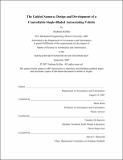| dc.contributor.advisor | Mark Drela and Timothy M. Barrows. | en_US |
| dc.contributor.author | Kellas, Andreas | en_US |
| dc.contributor.other | Massachusetts Institute of Technology. Dept. of Aeronautics and Astronautics. | en_US |
| dc.date.accessioned | 2008-09-02T17:54:17Z | |
| dc.date.available | 2008-09-02T17:54:17Z | |
| dc.date.copyright | 2007 | en_US |
| dc.date.issued | 2007 | en_US |
| dc.identifier.uri | http://hdl.handle.net/1721.1/42047 | |
| dc.description | Thesis (S.M.)--Massachusetts Institute of Technology, Dept. of Aeronautics and Astronautics, 2007. | en_US |
| dc.description | This electronic version was submitted by the student author. The certified thesis is available in the Institute Archives and Special Collections. | en_US |
| dc.description | Includes bibliographical references (p. 109-110). | en_US |
| dc.description.abstract | Accurate delivery of cargo from air to ground is currently performed using autonomously guided parafoil systems. These parafoils offer limited maneuverability and accuracy, and are often relatively complex systems with significant deployment uncertainty. The author has proposed, designed, and developed a novel precision airdrop system in the form of a samara. Consisting of a single wing, payload, and control system, the guided samara is mechanically simple, and when correctly configured, is globally stable during deployment and steady descent. The proposed control mechanisms grant the vehicle omni-directional glide slope control during autorotating descent. This is the first documented effort to develop an actively controlled vehicle of this form factor. The research presented in this thesis includes the conceptual design of the vehicle and several control schemes, development of a six degree-of-freedom computer simulation predicting the vehicle's flight performance, and the design, fabrication, and flight testing of a guided samara prototype. Over the course of the development, numerous free-flights were conducted with unguided samara models. Flight results and simulation results in various configurations yielded the discovery of several mechanisms critical to understanding samara flight. The free-flight simulation predicted descent and rotation rates within 10% of those observed during flight testing. Simulations of the guided samara predicted stability during control actuation as well as considerable control authority. Using a programmable microprocessor, hobby servo, and 2-axis electronic compass, a control system was developed. The guided samara prototype was flight tested at NASA Langley to attempt to demonstrate omni-directional glide slope control during descent. | en_US |
| dc.description.abstract | (cont.) Due to weather conditions and test circumstances, the demonstration was inconclusive. The simulation results and favorable performance of the developed control system indicate that guidance of the samara during autorotation is feasible, and only awaits favorable conditions for demonstration of this capability. | en_US |
| dc.description.statementofresponsibility | by Andreas Kellas. | en_US |
| dc.format.extent | 110 p. | en_US |
| dc.language.iso | eng | en_US |
| dc.publisher | Massachusetts Institute of Technology | en_US |
| dc.rights | M.I.T. theses are protected by
copyright. They may be viewed from this source for any purpose, but
reproduction or distribution in any format is prohibited without written
permission. See provided URL for inquiries about permission. | en_US |
| dc.rights.uri | http://dspace.mit.edu/handle/1721.1/7582 | en_US |
| dc.subject | Aeronautics and Astronautics. | en_US |
| dc.title | The guided samara : design and development of a controllable single-bladed autorotating vehicle | en_US |
| dc.title.alternative | Controllable single-bladed autorotating vehicle | en_US |
| dc.type | Thesis | en_US |
| dc.description.degree | S.M. | en_US |
| dc.contributor.department | Massachusetts Institute of Technology. Department of Aeronautics and Astronautics | |
| dc.identifier.oclc | 229893867 | en_US |
